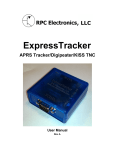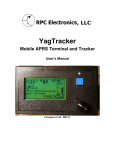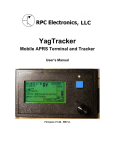Download Argent Data Systems OpenTracker USB User`s manual
Transcript
RTrak-HAB Integrated High Altitude Balloon APRS Tracker/Telemetry Payload User’s Manual Revision A Written By: Jason Rausch KE4'YV Copyright 2011 RPC Electronics, LLC Table of Contents 1. 2. 3. 4. 5. 6. Introduction and Acknowledgments Package Contents Device Overview and Specifications Connections Getting Started Basic APRS Programming • Callsign • Icon • APRS Path • Beacon Rate 7. Telemetry/Control Header 8. Dual-Frequency Operation 9. Major Component Specifications • OpenTracker 1+ • M'5010HS GPS Chipset • MX146LV VHF Transmitter Introduction Thank you for purchasing an RTrak-HAB! We are pleased that you have decided to make it part of your amateur radio equipment and hope that it will serve you well for many years to come. Please take some time to read through this manual and familiarize yourself with the functions of your new RTrak-HAB and how to operate it properly. Acknowledgments Special thanks to the following people for helping make the RTrak-HAB possible: Barry Sloan VE6SBS James Ewen VE6SRV Scott Miller N1VG Shaena Hicks KI4UDD Package Contents • Your new RTrak-HAB comes with everything required to get started. Included Items: • RTrak-HAB APRS Tracker • Embeddable Active GPS Patch Antenna • DB9 Serial to Header Programming Cable • CD Containing this manual and specification sheets on key components Device Overview and Specifications • The RTrak-HAB is the first APRS tracker designed specifically for the high altitude balloon community. We have worked closely with HAB enthusiasts to include all of the features needed for a truly versatile payload. OpenTracker 1+: The data modem section of the RTrak-HAB is based on the SMT OpenTracker 1+ platform. The OpenTracker was designed and programmed by Scott Miller N1VG of Argent Data Systems. The OT1+ platform is fully open source and a perfect match for the RTrak-HAB tracker. Firmware upgrades are free for download. Compernicus GPS: The GPS receiving chipset used in the RTrak-HAB. This GPS is a Sirf-Star III receiver with a fast <60 sec cold start lock time, measures only 20mm x 20mm in size and runs on a 3.3V operating voltage. The primary reason for using this GPS is the ability to track ABOVE 60,000 feet in altitude. MX146LV TX: The MX146LV VHF transmitter is a fully programmable 350mW transmitter and is frequency agile from 144-148 MHz. This module is temperature compensated for stabilization and makes it perfect for an HAB environment where constantly changing ambient temperatures can cause less capable transmitters to drift off of frequency. Connections Power The RTrak-HAB can be powered with any 5.5-12 VDC source. The LDO (Low Dropout Regulators) used allow for the tracker to be powered from battery for lightweight payloads. The connector is a three position solder pad connector suitable for direct soldering or a pin header for quick disconnect. GPS RF The GPS RF connection is a standard polarity, SMA female RF connector suited to mate with the included GPS active patch antenna. Be sure to tighten antenna connector finger tight. DO NOT use a wrench to torque the connector tight. This is not needed and risks damage to the connector or main RTrak-HAB board. Radio RF The radio RF connection is a standard polarity, SMA female RF connector. Be sure to tighten antenna connector finger tight. DO NOT use a wrench to torque the connector tight. This is not needed and risks damage to the connector or main RTrak-HAB board. Programming Port The programming port is a four pin header that mates with the included serial programming cable. Remove the shorting block when attempting to plug the serial cable in for programming. Ensure the unused contact of the plug is on the “D” pin. Important: When the RTrak-HAB is not being programmed, the included jumper block must be in place over the first two pins marked “D” and “R”, in order for the GPS data to be passed to the OpenTracker 1+! Power/RF Connection End Getting Started • Getting started is easy with the RTrak-HAB. 1. Connect power, VHF antenna and GPS antenna. 2. Install the programming software included on the RTrak-HAB User’s CD on any 3. 4. 5. 6. computer with a 9 pin serial port. Note: Some USB>Serial adapters have been reported to work with this software. Use at your own risk. Ensure that power to RTrak-HAB is REMOVED. Remove the jumper block and connect the programming cable to the RTrak-HAB’s programming port and the computer’s serial port. Plug power into the RTrak-HAB. Start up the RTrak programming software: rtrak-prog.exe. You will see a window like this: 7. Select the appropriate com port and click Connect. 8. If the software properly reads the RTrak-HAB, the connect window will close and open up a configuration window containing all of the current settings. • When you get to this point, proceed with the following page of Basic APRS Programming instructions. Basic APRS Programming • Callsign: Use your FCC assigned Amateur Radio callsign for this field Examples: KE4NYV KI4UDD N1VG • Callsign with SSID: The use of an SSID can aid in the multiple use of a single callsign. The SSID ID will be designated by a dash (-) sign and a number of 1-15. These SSIDs typically have specific meaning, so check with your local APRS users for the SSID that is appropriate for a non-receiving APRS tracker. Examples: KE4NYV-15 KI4UDD-12 N1VG-9 • Icon: The icon symbol will tell any receiving station what icon to use when displaying your position on an APRS map. Common APRS Icon Symbols Car Truck Van 18 Wheeler Bike Hiker Ambulance Jeep RV Airplane Boat • /> /k /v /u /b /[ /a /j /R /’ /Y Path: The path is used to route your packet as far as you would like it to go, within reason. Important! Due to the ability for a VHF signal to travel far at a high altitude, it is recommended that either a path of WIDE1-1 or no path is used when using the tracker for high altitude operations. Beacon Rates: The RTrak-HAB is capable of two beacon schemes. 1. Static Beacon – This method uses a pure timing scheme to beacon at a constant rate set in programming. This rate cannot be changed unless the configuration software and cable are used to make the change. The static beacon rate is set in seconds, meaning 30 = 30 seconds, 60 = 1 minute and so on. A typical static beacon rate is 3-5 minutes. 2. SmartBeaconing™ – This method uses the current GPS data to determine when to beacon and how often. There are two main elements to the SmartBeaconing™ algorithm: • • Speed-Adjusted Beacon Rate – Depending on your travel speed, the beacon rate is either increased or decreased. When traveling faster, the tracker is covering more ground and beacons more often. When traveling slower or stopped, the beacon rate is less often since it is not moving far or may be sitting still. Cornerpegging – While moving, the SB algorithm is constantly monitoring the heading of travel. When this degree of heading has changed past a certain threshold, it triggers a beacon to indicate either a long steady curve or a direct turn around a corner. The result is a much more defined track. • After all settings have been made, the last step is to write the configuration back to the RTrak-HAB. Click the “Write” button located in the bottom right of the configuration window. When the software is completed loading the settings, you will be asked to click the “OK!” button. The software returns to the main configuration screen where it can be exited. • Power down the RTrak-HAB by removing power from the power connection. Remove the programming cable, replace the jumper block and power the unit back up for normal operation. You are now ready to put your RTrak-HAB into service. 'OTE: Any additional settings can be found in the OpenTracker manual, included on the RTrak-HAB User’s CD Default Programming Window Telemetry/Control Header • The RTrak-HAB employs a full telemetry and controls package as part of the tracker payload. All ADC raw values are reported in the payload of the APRS packet. • The ADC (Analog to Digital Converter) channels can accept any analog voltage between 0-5VDC. These channels have on-board 3.3K pull-up resistors and 0.1uF decoupling capacitors. The GPO (General Purpose Output) channels can control numerous devices during flight. GPO 0-2 switches ground. GPO 3 switches +5VDC • Important! As of writing this document (4/15/2011) the GPO’s are not yet implemented in firmware. This will be added soon and this document will be updated to reflect that change. Telemetry/Control Header Pinout Dual-Frequency Operation • The RTrak-HAB is capable of operating on two independent VHF frequencies when in flight. This is accomplished by editing the frequency information in the configuration software. 1. The first step is to read the tracker’s current programmed profile with the configuration software. 2. Next, click on the “Freq” button to open up the editing window. 3. The frequency editor window will open up and have defaults loaded in the slots. 4. There are eight total frequency slots provided, but only two can be used at any given time. Normally, this would be slot 1 and slot 2. Use the selection dots (also known as “radio buttons”) to assign a frequency slot to the primary and secondary channels. Primary Channel is the default frequency used on power up and is controlled by the beaconing timing/scheme selected on the primary configuration window. Secondary Channel is used only at the specified beacon rate typed into the “Use secondary every” box. The example showed above will beacon on the primary frequency based on your beacon timing/scheme selected on the main page. The secondary frequency will be beaconed every 5 beacons on the main frequency. This gives you a 5:1 beacon ratio. Important! If SINGLE frequency operation is desired, set the primary AND secondary selection dots to slot 1. Also, make sure than the “beacon secondary every” box has a zero (0) typed into it. This will disable any dual-frequency options. Major Component Specifications • • • OpenTracker 1+ • Operating Voltage • Operating Current • Modes • Format • GPS Interface 5VDC Regulated 8 mA Idle, 20 mA Transmitting 1200 bps AFSK APRS Standard NMEA 4800 bps Trimble Compernicus GPS • Receiver Class • Channel • Operating Voltage • Cold Start Lock Time • Interface • Sensitivity • Maximum Altitude • Operating Current Sirf-Star III 20 3.25-3.3 VDC >30 Second NMEA-0183 -145dBm at Acquisition +60K Feet 30 mA SBR MX146LV Transmitter • Frequency Range • Operating Voltage • RF Transmit Power • Current Draw • Spacing • Modulation • Modulation BW • Spurious Suppression • Harmonic Suppression • Frequency Stability 144.000 – 148.000 MHz +5 VDC 350 mW 2 mA Idle, 300 mA Transmitting 2.5 kHz Dual Injection >20 kHz 80 dB 45 dB +/- 5ppm
























